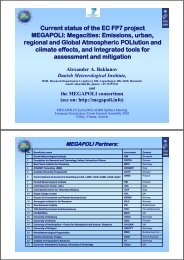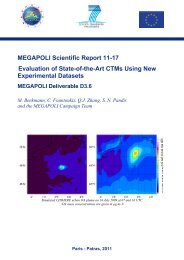D E S C R I P T I O N O F W O R K - MEGAPOLI - Dmi
D E S C R I P T I O N O F W O R K - MEGAPOLI - Dmi
D E S C R I P T I O N O F W O R K - MEGAPOLI - Dmi
Create successful ePaper yourself
Turn your PDF publications into a flip-book with our unique Google optimized e-Paper software.
<strong>MEGAPOLI</strong> 212520<br />
for 40% of Italy’s GDP. It is home to 37% of the country’s industry, about 55% of livestock, and<br />
35% of the country’s agricultural production. The Po valley is therefore exposed to substantial<br />
emission loads. The atmospheric circulation of the Po valley is characterised by the strong<br />
modification of synoptic flow due to the high mountains that surround the valley on three sides. The<br />
local atmospheric circulation features, dominated by calms and weak winds, favour the<br />
development of critical pollution episodes. Milan city and its surrounding urban area is located in<br />
the flat central part of the Po river basin. The core of Milan urban area, roughly coincident with its<br />
province, accounts for 3.7 millions inhabitants, while the commuting area includes around 7 million<br />
people (OECD, 2006). During the last decades, the urbanisation of the surrounding region has been<br />
enhanced by the re-settlement of part of the population from the city core to the surrounding region.<br />
The Rhine-Ruhr area is situated in the state of North Rhine-Westphalia, in Germany’s industrial<br />
heartland. It is home to cities like Bochum, Bottrop, Dortmund, Duisburg, Essen, Gelsenkirchen,<br />
Köln, Leverkusen, Solingen and Wuppertal, covers an area of about 10.000 km 2 and has a total<br />
population of more than 10 million people. With frequent west and south-west winds, the Rhine-<br />
Ruhr region is also downwind of other European megacities (London and Paris) and impacted by<br />
emissions from the Netherlands. Therefore, this region is not only exposed to “home made” new<br />
emissions but also to aged air from neighbouring regions. Due to the mostly hilly terrain of the<br />
region, air pollution and local climate are very heterogeneous and quite locally influenced.<br />
Figure 5: Population density in EU Figure 6: Loss in life expectancy (months)<br />
for 2003 (Source Eurostat). attributable to exposure to anthropogenic PM2.5<br />
for year 2000 emissions (Source: EC, IIASA)<br />
The four megacity areas identified above have different urban features and cover a wide range of<br />
topography, climate and atmospheric circulation conditions, providing a variety of different test<br />
cases for the evaluation and application of the <strong>MEGAPOLI</strong> modelling tools and the assessment of<br />
mitigation scenarios.<br />
Many fast-growing cities are located within and nearby Europe (e.g. Moscow, Cairo and Istanbul)<br />
and can directly affect European air quality and climate for example in the climate-change sensitive<br />
Mediterranean Basin. Moreover, the largest megacities with populations exceeding 20 million and<br />
showing continuous growing tendency, are located in developing countries in other continents. In<br />
those megacities air pollution abatement policies are still in their infancy and their emissions are<br />
expected to have a large effect on regional and global air quality and also climate. For these reasons<br />
the analysis of megacities effects at regional scale (WP1, WP4 and WP5) will include the 2nd level<br />
megacities listed in Figure 4. Mexico City will be investigated in detail because of the availability<br />
14




